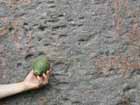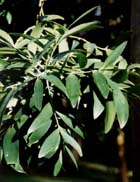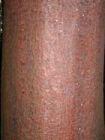Agathis robusta
(C.Moore ex F.Muell.) F.M.Bailey 1883
Common names
Queensland kauri, smooth-bark kauri (Newbury [no date]), kauri pine (Boland et al. 1985).
Taxonomic notes
There are two subspecies, distinguished by distribution and by pollen cone morphology:
- A. robusta subsp. robusta, syn. Dammara robusta C. Moore ex F. Muell. 1860; type location Australia, Cairns, Wide Bay.
- A. robusta subsp. nesophila Whitmore 1980, syn. A. spathulata de Laubenfels 1988, type Papua New Guinea, Morobe, Wau, Middle Creek.
Some authorities (Newbury [no date]) segregate the Fraser Island population as A. robusta and refer to the northern populations as A. palmerstonii. (Boland et al. 1985).
Description
Monoecious trees 25-30(-43) m tall and 100-150(-200) cm dbh; trunk straight with little taper, clear for over half its length; crown dense (Newbury [no date]). Bark orange-brown, brown or grey-brown; smooth to slightly flaky. Inner bark mixed red, pink and brown; bark exudate clear or somewhat milky (Boland et al. 1985). Shoots of two types, primary (from the branch) and lateral, diverging from primary shoots. Leaves spirally arranged on primary shoots, opposite to subopposite on lateral shoots; leaves entire on petioles 3-10 mm long, linear to elliptic, 5-13 × 1-4 cm, stiff; veins fine, longitudinal, more or less parallel. Juvenile leaves similar but oblong-lanceolate, acute, 6-7 × 1-2 cm, glabrous, green, shiny above and dull beneath, venation faint and longitudinal. Cotyledons 2, almost sessile, oblong or ovate, 3-4 × 1-1.5 cm; veins fine, indistinct, longitudinal, more or less parallel. Cones globular to cylindric, 9-15 × 8-10.5 cm. Cone scales 340-440, with those from the equatorial section 3.4-4.1 × 3.9-4.6 cm. Pollen cones shortly pedunculate or almost sessile, usually axillary on slender leafy twigs, cylindric, 4-8.5(10) × 0.7-0.9 cm at maturity, bearing 600-1300 microsporophylls, each with 2-8 pollen sacs on the underside. Maturity July-September (Boland et al. 1985). Seeds narrowly cordate, winged. Wood creamy white to pale brown, similar to that of Agathis microstachya but with a density of 435-480 kg m-3. Sapwood and heartwood difficult to distinguish (Newbury [no date], Boland et al. 1985).
Subsp. robusta has mature pollen cones up to 9 mm wide and obtuse-triangular microsporphylls with a raised head, 1×1 mm wide. Subsp. nesophila has mature pollen cones 9-13 mm wide and microsporophyll heads rhombic, not raised, 1.5-2 mm wide (Farjon 2010).
Similar species: The smooth bark, large male strobili with 600-1300 scales, and large cones with 340-440 scales distinguish this species from others of Agathis (Boland et al. 1985).
Distribution and Ecology
For subspecies robusta:
Australia: found in two disjunct areas, one in S Queensland between Tewantin and Maryborough (mainland) and on Fraser Island [latitude 25°-26.5° S]; the other in N Queensland between the Herbert River and Big Tableland near Cooktown [latitude 15.5°-18.5° S]. You can also create a highly detailed map, and access specimen data, using the "search" function at the Australia Virtual Herbarium.
Queensland kauri grows from near sea level to (in the N) 900 m. The northern distribution is humid tropical; the mean January maximum temperature is 30-32° C and the mean July minimum 13-19° C. The southern distribution is humid subtropical with January and July temperatures of ca. 30-32° C and 6-8° C respectively. Annual precipitation is ca. 1100-1800 mm, summer-wet; rainfall in the driest month (August or September) is 25-35 mm. Soils are deep, well-drained, developed on sand dunes (Fraser Island), basalt, metamorphic or granite rocks; the species develops best on the latter (Boland et al. 1985).
The species grows as a rainforest emergent and is dominant in dry marginal rainforest types. There are many associated rainforest trees, including in the northern part of its range hickory ash (Flindersia ifflaiana), silver ash (F. schottiana), brown tulip oak (Argyrodendron polyandrum), mararie (Pseudoweinmannia lachnocarpa), flame tree (Brachychiton acerifolius), stony backhousia (Backhousia hughesii), cadaga (Eucalyptus torelliana), candle nut (Aleurites moluccana) and Rhodamnia costata. In its southern range, it may be found with silver ash, mararie, flame tree, iron wood (Backhousia myrtifolia), Bennet's ash (Flindersia bennettiana) and brown malletwood (Rhodamnia trinervia) (Boland et al. 1985).
For subspecies nesophila:
Papua New Guinea: Eastern Highlands, Owen Stanley Range and New Britain, at elevations of 518-1676 m (Silba 1986, Farjon 2010).
The WCMC states that "Scattered emergents survive in small exposed groves of rainforest in the eastern highlands. Over exploitation of the timber is a threat." Based primarily upon risks of land clearance and the known area of occupancy, the IUCN has assigned "Vulnerable" status to this subspecies.
Remarkable Specimens
Reportedly, trees 255 cm dbh were measured historically on Fraser Island, but were later cut. The north population has also been heavily logged, but a tree 137 cm dbh and 43 m tall was measured in 2002 on the Skyrail Rainforest Cableway above Cairns. Ornamental trees are almost all from the Fraser Island population, and have grown nearly as large as the surviving wild trees. Outstanding examples include:
- DBH 210 cm, height 31.0 m, measured 2014. Located by Woollahra Council Offices, Sydney (National Register of Big Trees 2020).
- DBH 200 cm, height 39.2 m, crown is 25.3 m wide, measured 2006.12. This tree, planted in 1910, grows at Albury Botanic Gardens in Albury, Victoria (Robert Van Pelt e-mail 2008.03.19). A 2010 measurement of this tree found it to be DBH 210 cm, height 37.0 m (National Register of Big Trees 2012).
- DBH 202 cm, height 37.0 m, measured 2008. Located in Adelaide Botanic Gardens, Australia (National Register of Big Trees 2012).
- A tree in Yatton Park, Tauranga, New Zealand, planted ca. 1880. Measured in 2002 it was DBH 191 cm, height 32.0 m (Robert Van Pelt e-mail, 2003.01.27); by 2013 it had grown to 207 cm DBH, its height unchanged (New Zealand Notable Trees BPR/1026, 2013.01.09).
- DBH 169 cm, height 31.0 m, measured 2009. Located in Queens Park Gardens, Toowoomba, Queensland (National Register of Big Trees 2020).
- DBH 153 cm, height 27.1 m, measured 2003. Located in Arderne Gardens, Claremont, Cape Town, South Africa (Robert Van Pelt pers. comm., 2003.11.24).
Due to the absence of datable growth rings, no age data are available. Given the size of the species, and by analogy with other species of Agathis, maximum ages could reasonably be expected to exceed 300 years. However, the largest specimens now in cultivation are about 100 years old and are approaching the size of the largest recorded wild specimens, so it is possible that the oldest trees may not exceed 200 years.
Ethnobotany
This tree was first reported in 1842 by Andrew Petrie, who found it growing in the Mary River country. He reported that the native peoples made their nets from its inner bark (McInnes-King 2002).
Historically, "Because of the size of the trunk it was possible to obtain fairly wide boards.Very even texture. Seasons very readily with little movement. Not durable in contact with the ground, but otherwise stands up to exposure quite well. Easy to work and can be finished to a beautiful glossy surface. Stains and polishes well. Uses: Plywood, cabinet work, furniture, indoor fittings, boat building, turning. In early homes was used for kitchen sinks and bench tops, cutting boards, flooring.
The species was evaluated for use in dendrochronology. "[T]rees growing in a seasonal tropical climate in north Queensland produce latewood during cooler and drier periods. Vascular cambium growth rates fluctuate, and slow-growing trees temporarily have inactive cambium around parts of the trunk so no growth ring is formed. Radiocarbon dates on old Agathis trees indicate that the frequency of ring formation is less than annual" (Ash 1983). As of 2009, no further work is reported on this species.
Observations
Can be seen on Fraser Island. The best stand is said to be near the center of the island, requiring a two-day walk or the hire of a sand vehicle.
Remarks
Citations
Ash, J. 1983. Growth rings in Agathis robusta and Araucaria cunninghamii from tropical Australia. Australian Journal of Botany 31:269-275.
Bailey, Frederick Manson. 1883. A Synopsis of the Queensland Flora, p. 498.
McInnes-King, David. 2002. Tree Dinosaurs. Larnook, Australia: Souvenir Edition.
National Register of Big Trees. 2012. Tree Register: National Registry of Big Trees. www.nationalregisterofbigtrees.com.au, accessed 2012.06.23.
National Register of Big Trees. 2020. Tree details for Agathis robusta. https://www.nationalregisterofbigtrees.com.au/pages/home-page, accessed 2023.02.21.
Newbury, Keith. [no date]. WoodLink VWA Homepage. http://home.vicnet.net.au/~woodlink/woodlink.htm, accessed 2010.06.22, now defunct.
See also







